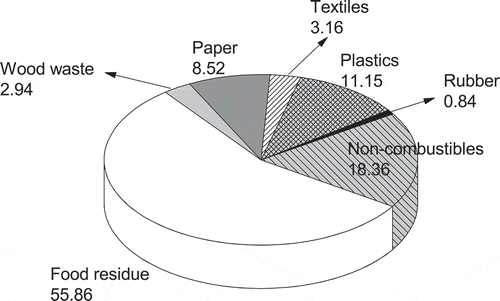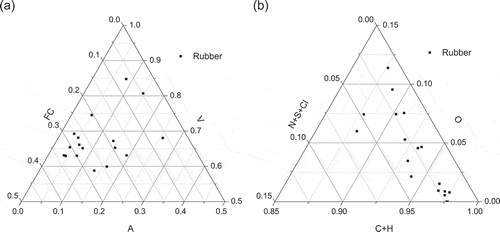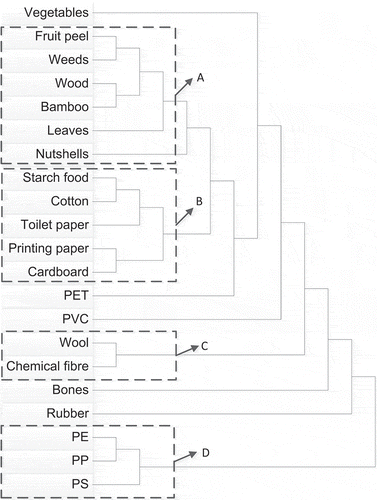Abstract
Municipal solid waste (MSW) has been normally sorted into six categories, namely, food residue, wood waste, paper, textiles, plastics, and rubber. In each category, materials could be classified further into subgroups. Based on proximate and ultimate analysis and heating value, statistical methods such as analysis of variance (ANOVA) and cluster analysis were applied to analyze the characteristics of MSW in every subgroup and to try to distinguish their relative properties. The chemical characteristics analysis of MSW showed that polyethylene (PE), polypropylene (PP), and polystyrene (PS) had the highest volatile matter content, with almost no ash and fixed carbon, while polyethylene terephthalate (PET) had high carbon content but low hydrogen content. Bones and vegetables had the highest ash content, while nutshells and rubber had the highest fixed carbon content. Paper and starch food had the highest oxygen content, and wool and bones had the highest nitrogen and sulfur content. Polyvinyl chloride (PVC) had the highest chlorine content at about 55%. PE, PP, and PS had the highest heating value, followed by chemical products such as rubber and chemical fiber. Conversely, paper, vegetables and bones had the lowest heating value. The results of cluster analysis of MSW components showed that fruit peel, weeds, wood, bamboo, leaves and nutshells could be classified as the lignocellulose category; starch food, cotton, toilet paper, printing paper and cardboard could be classified as the glucose monomer category; wood and chemical fiber could be classified as the high nitrogen and sulfur category; and PE, PP, and PS could be cluster as the polyolefin category.
Implications:
The yield of municipal solid waste (MSW) is constantly increasing and waste to energy (WTE) has been used extensively all over the world. During the processes of incineration, pyrolysis, or gasification, the impact of physical and chemical properties of MSW is of great significance. However, the traditional classification of MSW is too general to provide more detailed information in many investigations. It is necessary to perform the investigation of characteristics of combustible MSW to distinguish different categories of MSW and find out their subclassification.
Introduction
Municipal solid waste (MSW) generated in China has grown from 108.25 million tons in 1996 to 163.95 million tons in 2011 (National Bureau of Statistics of China [NBSC], 2012). Severe environmental problems will occur if the MSW cannot be disposed of properly (Tai et al., Citation2011). The traditional landfill method is facing a land shortage crisis (Dong et al., Citation2003), and waste to energy (WTE) methods such as incineration, pyrolysis, and gasification are drawing increasingly global concern (Liu and Liu, Citation2005).
Traditionally, MSW combustible fractions are divided to food residue, wood waste, paper, textiles, plastics, and rubber, six groups (MHUDC, 2009). shows the mean physical compositions of MSW in Chinese cities. The average physical combustible and noncombustible fractions of the MSW were 81.64% and 18.36%, respectively. In combustible MSW, the contents of food residue, plastics, paper, textiles, wood waste, and rubber, in decreasing order, were 55.86%, 11.15%, 8.52%, 3.16%, 2.94%, and 0.84%.
However, the classification of MSW is too general to provide more detailed information in many investigations. Many research studies were carried out using samples called food residue or plastics (Guo et al., Citation2001; Watanabe et al., Citation2004; Luo et al., Citation2010), while the groups themselves are very complex and may include subgroups of totally different properties. Plastics, for example, include polyethylene (PE), polystyrene (PS), and polyvinyl chloride (PVC), whose characteristics are completely different. Therefore, it is necessary to perform an investigation on characteristics of combustible MSW to distinguish different categories of MSW and find out their subclassification.
The proximate and ultimate analysis and heating value of MSW are fundamental parameters for incineration, pyrolysis, and gasification (Riber et al., Citation2009). This paper focuses on these thermochemical properties of the specific components of MSW. Analysis of variance (ANOVA) was adapted to analyze whether significant difference existed in MSW groups. Cluster analysis was carried out to classify MSW specific components. Therefore, some representatives can be selected during the experimental research of MSW.
Data and Discussion
Characterization and classification of specific components
Food residue
Food residue prevails in MSW categories, and is normally divided to five5 subgroups, namely, vegetables, fruit peel, bones, starch food, and nutshells. The proximate and ultimate analysis and heating value results of food residue are shown in . To eliminate the impact of moisture and ash, the ultimate analysis results were unified into dry ash free basis. Proximate analysis and higher heating value (HHV) were expressed on a dry weight basis.
Table 1. Chemical characteristics of food residue
The proximate and ultimate analysis results of food residue varieties are plotted in . Starch food, nutshells, and fruit peel had similar proximate analysis characteristics. The proximate analysis of vegetables and bones showed significant difference from other food residue subgroups. Bones had the highest ash content, followed by vegetables. Starch food had the highest volatile matter, followed by fruit peel. Based on elemental compositions, vegetables, fruit peel, starch food, and nutshells were close to each other, while bones had high C + H content, low O content, and high N + S + Cl content.
Figure 2. Chemical compositions of food residue specific components: (a) proximate analysis; (b) ultimate analysis.
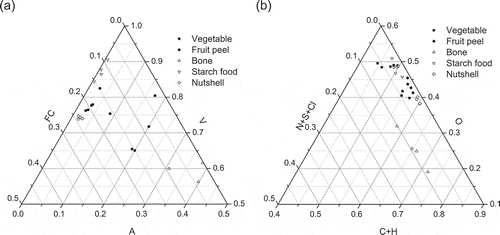
The data in are nearly normally distributed. Therefore, ANOVA was applied to investigate statistical significance of grouping the food residue, as shown in . The statistical significance level α was set as 0.05, which is commonly used in statistical analysis. Therefore, when the significance P was larger than α, there was no significant difference in food residue subgroups; when significance P was smaller than α, a significant difference existed among food residue subgroups (Agresti and Franklin, Citation2013). As shown in , there were significant differences in food residue subgroups for all variables.
Table 2. ANOVA of thermochemical properties in food residue subgroups
Table 3. Chemical characteristics of wood waste subgroups and varieties.
Cluster analysis was applied to classify the food residue subgroups. The variables included ash content (A), volatile content (V), fixed carbon content (FC), C, H, O, N, S, and HHV. All the variables were standardized to a value between 0 and 1. The linkage between groups method was employed as the cluster method. Calculation of distance between any two objects was based on the Euclidean distance (Janowitz, Citation2010). The critical clustering coefficient was set as 1.5, which was suitable for MSW subgroups clustering after many tests. Therefore, the cluster happened with and only with a clustering coefficient less than 1.5. All statistical analyses were performed by SPSS software. The results showed that food residue could be classified into two characteristic groups: (i) vegetables, fruit peel, starch food, and nutshells, and (ii) bones.
Wood waste
Wood waste in MSW can be divided into four subgroups: wood, bamboo, leaves, and weeds. The proximate and ultimate analysis and heating value results of wood waste are shown in .
The proximate and ultimate analysis results of wood waste are plotted in . Weeds and leaves had lower volatile matter and higher ash than wood and bamboo. The N + S + Cl content of wood waste varied from 0% to 5%. Significant difference in elemental composition was not observed for these subgroups. The HHV also showed little difference.
Figure 3. Chemical composition of wood waste specific components: (a) proximate analysis; (b) ultimate analysis.
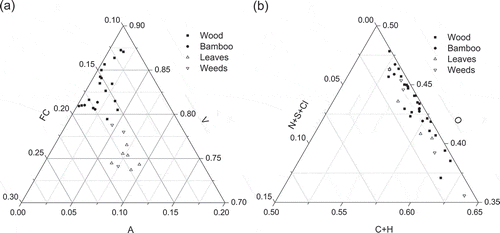
The ANOVAs of proximate and ultimate analysis and HHV among wood waste subgroups are shown in . Under the 0.05 significance level, A, V, and N + S + Cl showed significant differences, and the most significant was for ash content. Cluster analysis indicated that each subgroup was a class and cannot cluster with others with a clustering coefficient less than 1.5.
Table 4. ANOVA of thermochemical properties in wood waste subgroups
Paper
The paper in MSW can be divided into three subgroups, namely, printing paper (including newspapers, books, and magazines), cardboard, and toilet paper. The proximate and ultimate analysis and heating value results of paper are shown in .
Table 5. Chemical characteristics of paper subgroups and varieties
The proximate and ultimate analysis results of paper are plotted in . Toilet paper had the highest V and the lowest A, while the proximate analysis of printing paper and cardboard showed no significant difference, as shown in . The values of N + S + Cl content of paper samples were all less than 0.25%. Compared with cardboard, toilet paper had higher O and lower C + H, and the elemental composition of printing paper was in between. As shown in , the HHV decreasing order was toilet paper > cardboard > printing paper.
Figure 4. Chemical composition of paper specific components: (a) proximate analysis; (b) ultimate analysis.

The ANOVAs of proximate and ultimate analysis and HHV among paper subgroups are shown in . Under the 0.05 significance level, C + H and O showed significant difference, and other variables showed no significance. Cluster analysis indicated that paper could be classified to two clusters: (i) printing paper and cardboard, and (ii) toilet paper.
Table 6. ANOVA of thermochemical properties in paper subgroups
Textiles
The textiles in MSW can be divided into three subgroups, namely, cotton, chemical fibers, and wool. The proximate and ultimate analysis and heating value results of textiles are shown in .
Table 7. Chemical characteristics of textiles subgroups and varieties
The proximate analyses of different textiles samples were scattered, as shown in . Cotton had low A and various V and FC. The ash content of chemical fibers varied greatly. As shown in , the elemental composition of chemical fibers also showed great variance. The N content of acrylic fibers was as high as 20%, due to the monomer contained CN function group. The elemental composition of cotton was similar, and the N + S + Cl content was very low. The elemental composition of two wool samples varied greatly. As shown in , the HHV decreasing order was chemical fibers > wool > cotton.
Figure 5. Chemical composition of textiles specific components: (a) proximate analysis; (b) ultimate analysis.
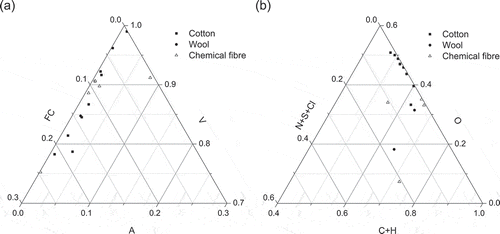
The ANOVA of proximate and ultimate analysis and HHV among textiles subgroups are shown in . Under the 0.05 significance level, C + H, O and HHV showed significant difference, and other variables showed no significance. Cluster analysis indicated that each subgroup was a class and cannot cluster with others with a clustering coefficient less than 1.5.
Table 8. ANOVA of thermochemical properties in textiles subgroups
Plastics
Unlike other MSW components, the plastic varieties tend to be pure. Five kinds of commonly used plastics include PE (including high-density polyethylene and low-density polyethylene), PP (polypropylene), PS, PVC, and PET (polyethylene terephthalate). The proximate and ultimate analysis and heating value results of plastics are shown in .
Table 9. Chemical characteristics of plastics subgroups and varieties
The proximate and ultimate analysis results of plastics are plotted in . The proximate analysis values of PE, PP, and PS were close to each other, with V nearly 100%. The proximate analysis of PVC varied greatly. Some PVC samples had little ash and some samples had an ash content as high as 15%. PET had more than 90% V and less than 10% FC. The C + H content of PE, PP, and PS was nearly 100%, and O, N, S, and Cl contents were almost zero, as shown in . The Cl content of PVC was between 50% and 60%, and the O content of PET was about 33%. The HHV in decreasing order was PP, PE, PS, PET, and PVC, and the HHV of PVC and PET was about half of that of PE, PP, and PS.
Figure 6. Chemical composition of plastics specific components: (a) proximate analysis; (b) ultimate analysis.

The ANOVA of proximate and ultimate analysis and HHV among plastics subgroups are shown in . Under the 0.05 significance level, all the variables except ash content showed significant difference. Cluster analysis indicated that plastics could be classified to three clusters: (i) PE, PP, PS, (ii) PVC, and (iii) PET.
Table 10. ANOVA of thermochemical properties in plastics subgroups
Rubber
Since rubber in MSW was mainly derived from waste tires, it was not subdivided for this paper. The proximate and ultimate analysis and heating value results of rubber are shown in .
Table 11. Chemical characteristics of rubber varieties
As shown in , the mean C content of rubber was 85.01%. The reason was that in addition to the high C content of the rubber polymer monomer, carbon black was usually added to tires to enhance wear resistance. Rubber had high H content, low O content, and high S and Cl content. Meanwhile, the HHV of rubber was as high as 31,989 kJ/kg. The proximate and ultimate analysis of different rubber samples varied significantly, as shown in .
Comparison and classification of MSW specific components
Comparison of MSW specific components
From 2.1.1 to 2.1.6, the proximate and ultimate analysis and HHV of MSW specific components were compared, as shown in . Bones and vegetables had the highest A, while PE, PP, PS, PET, and toilet paper had the highest V and the lowest A and FC. The FC of nutshells and rubber was the highest. PE, PP, PS, and rubber had the highest C and H, while the C and H of PVC were relatively low, due to high Cl. PET had high C but low H. Paper and starch food had the highest O, while PE, PP, and PS had no O and N. Wool was a keratin, a fibrous insoluble animal protein (Pine et al., Citation1981), and bone contained protein, so they had high N and S. Chemical fiber had the highest N, because of acrylic fiber. The HHVs of PE, PP, and PS were the highest and artificial polymers such as rubber and chemical fiber also had high HHVs, while HHV values of paper, vegetables, and bones were the lowest.
Table 12. The comparison of the characteristics of MSW specific components
Classification of MSW specific components
Cluster analysis was applied to classify MSW specific components. The variables included A, V, FC, C, H, O, N, S, and HHV, as shown in . Fruit peel, weeds, wood, bamboo, leaves, and nutshells could be clustered, as shown in Area A. The components of this cluster were composed of pectin, hemicellulose, cellulose, and lignin, with high FC and medium other indicators. Area B included starch food, cotton, toilet paper, printing paper, and cardboard. It seemed that their components were unrelated. However, the main ingredient of paper was cellulose (Wu et al., Citation2003), and cotton also contained 95% cellulose (Abidi et al., Citation2010), which had the same glucose monomer as starch food (Pine et al., Citation1981). Wool and chemical fiber were clustered as shown in Area C, which had low H and O, and high N, S, and HHV. PE, PP, and PS had the most similarity, as shown in Area D. The properties of this cluster were high V (nearly 100%), C, H, and HHV, and low O, N, A, and FC. Vegetables, PET, PVC, bones, and rubber had more complex composition, and thus they could not be classified into the four categories just described.
Conclusion
The proximate and ultimate analysis and heating value of MSW specific components were analyzed and statistical methods such as ANOVA and cluster analysis were applied. Bones and vegetables had the highest ash content, and nutshells and rubber had the highest fixed carbon content. The carbon and hydrogen content of PVC was low and the chlorine content was very high, accordingly. PET had high carbon content and low hydrogen content. Paper and starch food had the highest oxygen content, and wool and bones had the highest nitrogen and sulfur content. The sulfur and chlorine content of rubber was relatively high. PE, PP, and PS had the highest heating value, and the heating values of chemical products such as rubber and chemical fiber were also very high. Conversely, paper, vegetables, and bones had the lowest heating value. The cluster analysis of MSW components was applied based on proximate and ultimate analysis and heating value results. The results showed that fruit peel, weeds, wood, bamboo, leaves, and nutshells could be classified as a category; starch food, cotton, toilet paper, printing paper, and cardboard could be classified as a category; wood and chemical fiber could be classified as a category; and PE, PP, and PS could be clustered as a category.
Funding
Financial support from the National Basic Research Program of China (973 Program, no. 2011CB201502) and National Natural Science Foundation of China (no. 21376134) is gratefully acknowledged.
Additional information
Notes on contributors
Hui Zhou
Yanguo Zhang is a professor, Qinghai Li is an associate professor, and Hui Zhou, Aihong Meng, and Yanqiu Long are Ph.D. candidates at the Key Laboratory for Thermal Science and Power Engineering of Ministry of Education, Department of Thermal Engineering, Tsinghua University, Beijing, China.
Aihong Meng
Yanguo Zhang is a professor, Qinghai Li is an associate professor, and Hui Zhou, Aihong Meng, and Yanqiu Long are Ph.D. candidates at the Key Laboratory for Thermal Science and Power Engineering of Ministry of Education, Department of Thermal Engineering, Tsinghua University, Beijing, China.
Yanqiu Long
Yanguo Zhang is a professor, Qinghai Li is an associate professor, and Hui Zhou, Aihong Meng, and Yanqiu Long are Ph.D. candidates at the Key Laboratory for Thermal Science and Power Engineering of Ministry of Education, Department of Thermal Engineering, Tsinghua University, Beijing, China.
Qinghai Li
Yanguo Zhang is a professor, Qinghai Li is an associate professor, and Hui Zhou, Aihong Meng, and Yanqiu Long are Ph.D. candidates at the Key Laboratory for Thermal Science and Power Engineering of Ministry of Education, Department of Thermal Engineering, Tsinghua University, Beijing, China.
Yanguo Zhang
Yanguo Zhang is a professor, Qinghai Li is an associate professor, and Hui Zhou, Aihong Meng, and Yanqiu Long are Ph.D. candidates at the Key Laboratory for Thermal Science and Power Engineering of Ministry of Education, Department of Thermal Engineering, Tsinghua University, Beijing, China.
References
- Abidi, N., E. Hequet, and L. Cabrales. 2010. Changes in sugar composition and cellulose content during the secondary cell wall biogenesis in cotton fibers. Cellulose 17 (1): 153–60. doi:10.1007/s10570-009-9364-3
- Agresti, A., and C. Franklin. 2013. Statistics: The Art and Science of Learning from Data, 3rd ed. Boston, MA: Pearson Education.
- Bai, G., Y. Wang, Q. Bai, and X. Chu. 2007. Pyrolysis characteristics study of simulative medical waste on cannular electric furnace. Chinese J. Environ. Eng. 1: 128–32 ( in Chinese).
- Chen, H., H. Sui, X. Wang, X. Dai, and H. Yang. 2012. Effects of temperature on the product property during multi-cogeneration based on waste tyre pyrolysis. P. CSEE 32:119–25 ( in Chinese).
- Chi, Y., J. Zheng, Y. Jin, H. Mi, X. Jiang, and M. Ni. 2008. Experimental study on fluidized-bed gasification of simulated MSW. P. CSEE 28: 59–63 ( in Chinese).
- Dai, K. 2007. Experimental study on compositions variation on waste combustion of a fixed bed. Harbin, China: Harbin Institute of Technology (in Chinese).
- Dai, X. W., X.L. Yin, C.Z. Wu, W.N. Zhang, and Y. Chen. 2001. Pyrolysis of waste tires in a circulating fluidized-bed reactor. Energy 26 (4): 385–99. doi:10.1016/S0360-5442(01)00003-2
- Deng, D., X. Liu, and H. Liao. 2010. Thermogravimetric characteristic of waste tyre in co-pyrolysis with coal. Environ. Prot. Chem. Ind. 30: 117–20 ( in Chinese).
- Dong, C. Q., B.S. Jin, Z.P. Zhong, and J.X. Lan. 2002. Tests on co-firing of municipal solid waste and coal in a circulating fluidized bed. Energ. Conversion Manage. 43 (16): 2189–99. doi:10.1016/S0196-8904(01)00157-1
- Dong, C.Q., B.S. Jin, and D.J. Li. 2003. Predicting the heating value of MSW with a feed forward neural network. Waste Manage. 23 (2): 103–6. doi:10.1016/S0956-053X(02)00162-9
- Fang, C., H. Fan, and J. Wang. 2010. Study on release characteristics of gaseous products during biomass pyrolysis process. Boiler Technol. 41: 71–75 ( in Chinese).
- Feng, X., S. Long, L. Zhang, Y. Chen, and J. Hua. 2006. Pyrolysis characteristics and kinetics of waste plastics and coal powder. J. Iron Steel Res. 18: 11–14 ( in Chinese).
- Fu, X., Z. Zhong, G. Xiao, and R. Li. 2009. Comparative study on characteristics and dynamics of pyrolysis process of grass biomass. Boiler Technol. 40: 66–70 ( in Chinese).
- Guo, X.F., Z.Q. Wang, H.B. Li, H.T. Huang, C.Z. Wu, Y. Chen, and B.Q. Li. 2001. A study on combustion characteristics and kinetic model of municipal solid wastes. Energy Fuel 15 (6): 1441–46. doi:10.1021/ef010068f
- He, M.Y., B. Xiao, Z.Q. Hu, S.M. Liu, X.J. Guo, and S.Y. Luo. 2009. Syngas production from catalytic gasification of waste polyethylene: Influence of temperature on gas yield and composition. Int. J. Hydrogen Energy 34 (3): 1342–48. doi:10.1016/j.ijhydene.2008.12.023
- Hu, G., X. Zhu, and X. Zhou. 2011. Waste incineration power generation and secondary pollution control technology. Chongqing, China: Chongqing University Press (in Chinese).
- Hu, G.X., and H. Huang. 2009. Hydrogen rich fuel gas production by gasification of wet biomass using a CO2 sorbent. Biomass Bioenergy 33 (5): 899–906. doi:10.1016/j.biombioe.2009.02.006
- Hu, X. 2010. Research on biomass flash pyorlysis producing bio-oil. Qingdao, China: Shandong University of Science and Technology (in Chinese).
- Janowitz, M.F. 2010. Ordinal and Relational Clustering. Singapore: World Scientific Publishing Co.
- Jiang, X., X. Li, Y. Chi, and J. Yan. 2004. Experimental study of emission of HCl on incinerating of typical MSW components and coal in fluidized bed. P. CSEE 24:213–17 (in Chinese).
- Jin, L., Y. Gao, W. Bao, and Q. Cao. 2007. Influence of co-pyrolysis for the mixture of biomass and waste tires on pyrolytic liquid property. Mod. Chem. Ind. 27:34–38 ( in Chinese).
- Jin, Y. 2002. Study on MSW combustion characteristics and a new CFB incineration technology. Hangzhou, China: Zhejiang University (in Chinese).
- Jin, Y., J. Yan, Y. Chi, X. Li, and K. Cen. 2001. Study on kinetics of pyrolysis of PVC. J. Fuel Chem. Technol. 29:381–84 (in Chinese).
- Ke, W., W. Xiong, J. Liu, L. Wei, L. Zhou, X. Bao, J. Xiang, and J. Guo. 2006. Thermogravimetric analysis and pyrolytic kinetic study on municipal solid wastes (MSW). Renew. Energy 129: 53–56 (in Chinese).
- Lan, X., Q. Liu, and Y. Song. 2012. Study on co-pyrolysis of low rank coal and plastic with microwave. Coal Conversion 35: 16–19 (in Chinese).
- Li, A., Z. Wang, S. Li, and J. Yan. 2002. A study of the pyrolytic semicoke characteristics of solid waste. J. Eng. Thermal Energy Power 17:132–39 ( in Chinese).
- Li, A.M., X.D. Li, S.Q. Li, Y. Ren, Y. Chi, J.H. Yan, and K.F. Cen. 1999a. Pyrolysis of solid waste in a rotary kiln: influence of final pyrolysis temperature on the pyrolysis products. J. Anal. Appl. Pyrol. 50 (2):149–62. doi:10.1016/S0165-2370(99)00025-X
- Li, A.M., X.D. Li, S.Q. Li, Y. Ren, N. Shang, Y. Chi, J.H. Yan, and K.F. Cen. 1999b. Experimental studies on municipal solid waste pyrolysis in a laboratory-scale rotary kiln. Energy 24 (3): 209–18. doi:10.1016/S0360-5442(98)00095-4
- Li, B., J. Yan, N. Shang, Y. Chi, and X. Jiang. 1998. Study on combustion characteristics of municipal solid waste (MSW). J. Fuel Chem. Technol. 26: 85–89 ( in Chinese).
- Li, D., W. Li, and B. Li. 2001a. Co-carbonization of coking coal with different waste plastics. J. Fuel Chem. Technol. 29: 19–23 ( in Chinese).
- Li, L., and H. Zhang. 2004. Study on production of levoglucosan from organic solid wastes by pyrolysis. Tech. Eq. Environ. Pollut. Control 5:21–23 ( in Chinese).
- Li, M., J. Chen, X. Sun, and X. Yu. 2001b. Macroscopical reaction mechanism of combustibles in municipal solid waste. J. Huazhong Univ. Sci. Technol. 29:97–99 ( in Chinese).
- Li, W., B. Li, C. Sun, W. Yuchi, and B. Cao. 1996. Study on pyrolysis and hydropyrolysis of biomass and copyrolysis between biomass and coal. J. Fuel Chem. Technol. 24: 341–47 ( in Chinese).
- Li, X., J. Yan, Y. Cao, Y. Chi, J. Gu, Z. Ma, and K. Cen. 2004. Emission characteristics of typical gas pollutants during pyrolysis of waste tires in fluidized bed reactor. J. Zhejiang Univ. (Eng. Sci.) 38: 888–92 ( in Chinese).
- Li, Y.J., A.M. Li, R.D. Li, Z. Wang, L.H. Wei, and S.Q. Qin. 2005. Experimental study of solid waste gasification with oxygen-rich and analysis of grey relation gradient. Acta Energy Sol. Sin. 26: 543–48 ( in Chinese).
- Lian, F., B.S. Xing, and L.Y. Zhu. 2011. Comparative study on composition, structure, and adsorption behavior of activated carbons derived from different synthetic waste polymers. J. Colloid Interface Sci. 360 (2): 725–30. doi:10.1016/j.jcis.2011.04.103
- Liang, J., X. Li, M. Yan, S. Lu, and J. Yan. 2012. Inorganic chlorine released from typical components of medical waste in pyrolysis/incineration. Chem. Ind. Eng. Prog. 31:927–32 (in Chinese).
- Liu, H. 2008. Experimental study of the characteristics of municipal solid waste gasification. Kunming, China: Kunming University of Science and Technology (in Chinese).
- Liu, H., M. Wang, M. Gao, Y. Li, and G. Lin. 1999. Study on approaches for estimation heat value of municipal solid waste. Environ. Sanit. Eng. 7: 100–6 ( in Chinese).
- Liu, P. 2007. Study on the gasification-incineration of municipal solid wastes in circulating fluidized bed. Beijing, China: Chinese Academy of Sciences (in Chinese).
- Liu, X., Y. Zhang, J. Sun, T. Ding, and Y. Cao. 2012. Analysis of Pennisetum americanum pyrolysis process based on the technique of thermo-gravimetric analysis coupled with infrared spectroscopy. J. Nanjing For. Univ. (Nat. Sci. Ed.) 36: 120–24 ( in Chinese).
- Liu, Y.S., and Y.S. Liu. 2005. Novel incineration technology integrated with drying, pyrolysis, gasification, and combustion of MSW and ashes vitrification. Environ. Sci. Technol. 39 (10): 3855–63. doi:10.1021/es040408m
- Luo, S. 2010. Research on municipal solid waste shredder and effect of particle size on pyrolysis & gasification performance. Wuhan, China: Huazhong University of Science and Technology (in Chinese).
- Luo, S.Y., B. Xiao, Z.Q. Hu, and S.M. Liu. 2010. Effect of particle size on pyrolysis of single-component municipal solid waste in fixed bed reactor. Int. J. Hydrogen Energy 35 (1): 93–97. doi:10.1016/j.ijhydene.2009.10.048
- Ma, G., G. Liu, Q. Cao, and W. Bao. 2007. Influence of co-pyrolysis of different species biomass with waste tires on oil properties. Mod. Chem. Ind. 27: 249–52 ( in Chinese).
- MHUDC (Ministry of Housing and Urban-Rural Development of China). 2009. CJ/T 313-2009 Sampling and Analysis Methods for Domestic Waste (in Chinese). Beijing, China.
- Mi, Z., Z. Gao, and M. Qi. 1993. Treatment and Disposal of Solid Waste. Beijing, China: Higher Education Press (in Chinese).
- Miao, C. 2005. The experimental study on co-pyrolysis of coal and plastic. Nanjing, China: Nanjing University of Technology (in Chinese).
- Miao, Q. 2006. Experimental research on gasification characteristics of filtrated MSW in fluidized beds. Hangzhou, China: Zhejiang University (in Chinese).
- Na, D., Z. Yu-Feng, and W. Yan. 2008. Thermogravimetric analysis and kinetic study on pyrolysis of representative medical waste composition. Waste Manage. 28 (9): 1572–80. doi:10.1016/j.wasman.2007.05.024
- National Bureau of Statistics of China. 2012. China Statistical Yearbook, 2012. Beijing, China: China Statistics Press (in Chinese).
- Nie, Y. 2000. Waste Treatment Engineering Manual. Beijing, China: Chemical Industry Press (in Chinese).
- Pine, S.H., J.B. Hendrickson, D.J. Cram, and G.S. Hammond. 1981. Organic Chemistry, 4th ed. Singapore: McGraw-Hill Book Company.
- Pu, K., L. Zhang, and M. Xin. 2006. Experimental study on pyrolysis and combustion characteristic of King grass. P. CSEE 26:65–69 ( in Chinese).
- Qing, S., H. Wang, Z. Wu, and S. Wang. 2005. Study on characteristics of combustion of municipal solid waste with thermal analyzers. Environ. Pollut. Control 27: 24–28 ( in Chinese).
- Ren, H., Y. Zhang, Y. Fang, and Y. Wang. 2011. Co-gasification behavior of meat and bone meal char and coal char. Fuel Process. Technol. 92 (3): 298–307. doi:10.1016/j.fuproc.2010.09.013
- Riber, C., C. Petersen, and T.H. Christensen. 2009. Chemical composition of material fractions in Danish household waste. Waste Manage. 29 (4): 1251–57. doi:10.1016/j.wasman.2008.09.013
- Shao, Q., J. Peng, Q. Xu, J. Huang, and W. Li. 2006. Study on pyrolysis characteristics and kinetics of bamboo under liner heating temperature. Acta Energ. Sol. Sin. 27:671–76 ( in Chinese).
- Shen, X. 2005. Studies on pyrolysis and incineration of medical waste in rotary kiln. Hangzhou, China: Zhejiang University (in Chinese).
- Shen, X., J. Yan, C. Bai, X. Li, Y. Chi, M. Ni, and K. Cen. 2006. Optmization and comparison of pyrolysis kinetic model for typical MSW components. J. Chem. Ind. Eng. (China) 57: 2433–38 ( in Chinese).
- Song, C., M. Fang, C. Yu, Z. Luo, and K. Cen. 2005. Study on the characteristics of fir pyrolysis and combustion in thermal balance for simulating typical fire condition. J. Fuel Chem. Technol. 33:68–73 ( in Chinese).
- Su, Y., X. Zhang, and B. Zhao. 2008. Pyrolysis of waste tire powder and its dynamic model. J. Donghua Univ. (Nat. Sci.) 34: 740–43 ( in Chinese).
- Tai, J., W.Q. Zhang, Y. Che, and D. Feng. 2011. Municipal solid waste source-separated collection in China: A comparative analysis. Waste Manage. 31 (8): 1673–82. doi:10.1016/j.wasman.2011.03.014
- Tang, L., H. Huang, Z. Zhao, and C. Wu. 2003a. Pyrolysis of waste polypropylene in a nitrogen plasma reactor—effect of steam injection on improving gas quality. J. Fuel Chem. Technol. 31:476–79 ( in Chinese).
- Tang, S., D. Li, Z. Lv, and Y. Shen. 2003b. Simulation of biomass pyrolysis with chaotic neural network model. J. Chem. Ind. Eng. (China) 54: 783–789 ( in Chinese).
- Teng, H., S. Li, and Q. Lv. 2011. Experimental study on agglomeration characteristics of king-grass combustion in fluidized bed. Renew. Energy Resources 29: 121–24 ( in Chinese).
- Wang, G., and A. Li. 2008. Thermal decomposition and kinetics of mixtures of polylactic acid and biomass during copyrolysis. Chin. J. Chem. Eng. 16 (6):929–33. doi:10.1016/S1004-9541(09)60018-5
- Wang, M. 2007. Research on the carbonization pyrolysis characteristic of chestnut shell and sawdust. Harbin, China: Northeast Agricultural University (in Chinese).
- Wang, Q., Q. Liu, B. He, S. Wang, Z. Luo, and K. Cen. 2008. Experimental research on biomass flash pyrolysis for bio-oil in a fluidized bed reactor. J. Eng. Thermophys. 29:885–88 ( in Chinese).
- Wang, S., F. Liang, and J. Wang. 2003. Recycling Technology and Application of Solid Waste. Beijing, China: Metallurgical Industry Press (in Chinese).
- Watanabe, N., O. Yamamoto, M. Sakai, and J. Fukuyama. 2004. Combustible and incombustible speciation of Cl and S in various components of municipal solid waste. Waste Manage. 24 (6): 623–32. doi:10.1016%2Fj.wasman.2004.03.003
- Wu, C.H., C.Y. Chang, C.H. Tseng, and J.P. Lin. 2003. Pyrolysis product distribution of waste newspaper in MSW. J. Anal. Appl. Pyrol. 67 (1): 41–53. doi:10.1016%2FS0165-2370%2802%2900016-5
- Wu, H., H. Li, and Z. Zhao. 2009. Thermogravimetric analysis and pyrolytic kinetic study on coal/biomass blends. J. Fuel Chem. Technol. 37:538–45 ( in Chinese).
- Xiao, G., M. Ni, H. Huang, Y. Chi, R. Xiao, Z. Zhong, and K. Cen. 2007. Fluidized-bed pyrolysis of waste bamboo. J. Zhejiang Univ. Sci. A 8: 1495–99. doi:10.1631%2Fjzus.2007.A1495
- Xiao, G., M.J. Ni, Y. Chi, B.S. Jin, R. Xiao, Z.P. Zhong, and Y.J. Huang. 2009. Gasification characteristics of MSW and an ANN prediction model. Waste Manage. 29 (1):240–44. doi:10.1016/j.wasman.2008.02.022
- Xiao, J., L. Shen, Z. Wang, and X. Zhong. 2005. Pressurized thermogravimetric analysis of pyrolysis of biomass. J. Combust. Sci. Technol. 11: 31–36 ( in Chinese).
- Yan, J., X. Shen, X. Jiang, P. Su, J. Li, Y. Chi, and K. Cen. 2005. Study on pyrolysis-gasification of typical medical waste components in rotary kiln under batch feeding. Acta Sci. Circumst. 25: 1211–18 ( in Chinese).
- Yan, J.H., H.M. Zhu, X.G. Jiang, Y. Chi, and K.F. Cen. 2009. Analysis of volatile species kinetics during typical medical waste materials pyrolysis using a distributed activation energy model. J. Hazard. Mater. 162 (2–3): 646–51. doi:10.1016/j.jhazmat.2008.05.077
- Zhang, C., J. Yu, D. Fan, and M. Zhang. 2008a. A study of pyrolysis characteristics and kinetic analysis of typical constituents of municipal solid wastes in China. J. Eng. Therm. Energy Power 23:561–66 ( in Chinese).
- Zhang, C.S., R.Q. Zhang, X.P. Li, Y.W. Li, W. Shi, X.T. Ren, and X.M. Xu. 2011a. Bench-scale fluidized-bed fast pyrolysis of peanut shell for bio-oil production. Environ. Prog. Sustain. Energy 30 (1): 11–18. doi:10.1002/ep.10530
- Zhang, D., X. Li, J. Yan, Y. Chi, and K. Cen. 2003. No emission characteristics in fluidized bed combustion of waste. J. Fuel Chem. Technol. 31:322–27 ( in Chinese).
- Zhang, J. 2005. Research on pyrolysis & gasification characteristics of typical MSW components in fluidized beds. Hangzhou, China: Zhejiang University (in Chinese).
- Zhang, J., W. Liu, S. Ren, J. Song, and Y. Wen. 2012. Effect of waste plastics addition ratio on combustion of pulverized coal. Chinese J. Process Eng. 12:810–15 ( in Chinese).
- Zhang, R. 2002. Research on heavy metal distribution from municipal solid waste incineration. Hangzhou, China: Zhejiang University (in Chinese).
- Zhang, X., J. Chang, T. Wang, Q. Zhang, and L. Ma. 2005. Vacuum pyrolysis of waste tires with basic additives. J. Fuel Chem. Technol. 33:713–16 ( in Chinese).
- Zhang, Y., Y. Chen, A. Meng, Q. Li, and H. Cheng. 2008. Experimental and thermodynamic investigation on transfer of cadmium influenced by sulfur and chlorine during municipal solid waste (MSW) incineration. J. Hazard. Mater. 153 (1–2): 309–19. doi:10.1016/j.jhazmat.2007.08.054
- Zhang, Y., L. Wang, Z. Wang, and Q. Li. 2007a. Study on combustion property of typical compositions for MSW by using TG-FTIR method. Thermal Power Gener. 6: 23–28 ( in Chinese).
- Zhang, Y.G., Q.H. Li, A.H. Meng, and C.H. Chen. 2011b. Carbon monoxide formation and emissions during waste incineration in a grate-circulating fluidized bed incinerator. Waste Manage. Res. 29 (3): 294–308. doi:10.1177/0734242X10368581
- Zhang, Z., H. Wang, Y. Chen, and P. Xu. 2007b. Pyrolysis products of six organic solid wastes. Environ. Pollut. Control 29: 816–19 ( in Chinese).
- Zhao, L., Z. Wang, D. Chen, X. Ma, and J. Luan. 2012. Influence of impurities on waste plastics pyrolysis: products and emissions. Environ. Sci. 33:329–36 ( in Chinese).
- Zhao, Y., T.H. Christensen, W.J. Lu, H.Y. Wu, and H.T. Wang. 2011. Environmental impact assessment of solid waste management in Beijing City, China. Waste Manage. 31 (4): 793–99. doi:10.1016%2Fj.wasman.2010.11.007
- Zhao, Y., J. Liu, R. Li, and Y. Nie. 2007. De-volatilization kinetics of the combustible components in municipal solid waste. J. Tsinghua Univ. (Sci. Technol.) 47:842–46 ( in Chinese).
- Zhao, Y., D. Niu, and X. Chai. 2006. Treatment and recycling of solid wastes. Beijing, China: Chemical Industry Press (in Chinese).
- Zheng, J., Y.Q. Jin, Y. Chi, J.M. Wen, X.G. Jiang, and M.J. Ni. 2009. Pyrolysis characteristics of organic components of municipal solid waste at high heating rates. Waste Manage. 29 (3): 1089–94. doi:10.1016/j.wasman.2008.06.034
- Zhou, H., Y. Long, A. Meng, Q. Li, and Y. Zhang. 2013. The pyrolysis simulation of five biomass species by hemi-cellulose, cellulose and lignin based on thermogravimetric curves. Thermochim. Acta 566:36–43. doi:10.1016/j.tca.2013.04.040
- Zhou, L., T. Luo, and Q. Huang. 2009. Co-pyrolysis characteristics and kinetics of coal and plastic blends. Energ. Convers. Manage. 50 (3): 705–10. doi:10.1016/j.enconman.2008.10.007
- Zhou, L., Y. Wang, Q. Huang, and J. Cai. 2007. TG analysis and kinetics of biomass/plastics co-pyrolysis. Acta Energ Sol Sin.. 28: 979–83 ( in Chinese).
- Zhou, S., Z. Liu, and G. Zhang. 2001. Study on co-pyrolosis of strongly caking coal with solid organic waste. Coal Conversion 24: 70–73 ( in Chinese).
- Zhu, H.M., X.G. Jiang, J.H. Yan, Y. Chi, and K.F. Cen. 2008. TG-FTIR analysis of PVC thermal degradation and HCl removal. J. Anal. Appl. Pyrol. 82 (1): 1–9. doi:10.1016/j.jaap.2007.11.011
- Zhu, S. 2011. An experimental research on the impact of particle size on pyrolysis performance of MSW. Wuhan, China: Huazhong University of Science and Technology (in Chinese).
- Zou, Y., G. Wang, C. Zou, and C. Lai. 2006. Confirm thermal value of domestic refuse by revised physical analogy. China Environ. Prot. Ind. : 43–45 ( in Chinese).

